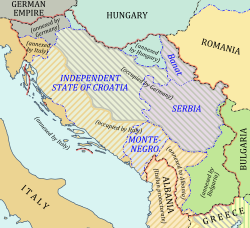
Back الاحتلال الهنغاري لمقاطعات يوغوسلافية Arabic Délvidék magyar uralom alatt 1941–1944 Hungarian Pendudukan wilayah Yugoslavia oleh Hungaria ID Occupazione ungherese dei territori jugoslavi Italian Ocupa magiar de teritorios iugoslavian LFN Оккупация территории Югославии Венгрией Russian Mađarska okupacija Bačke, Baranje, Prekomurja i Međimurja Serbo-Croatian Мађарска окупација Југославије Serbian Угорська окупація югославських земель Ukrainian
Hungarian occupation of Yugoslav territories | |
|---|---|
 | |
| Country | |
| Occupied by Hungary | 11 April 1941 |
| Annexed by Hungary | 14 December 1941 |
| Occupied by Germany | 15 March 1944 |
| Territories | |
| Government | |
| • Type | incorporated into existing Hungarian counties |
| • Body | Bács-Bodrog, Baranya, Zala, Vas |
| Area | |
| • Total | 11,475 km2 (4,431 sq mi) |
| Population (1941) | |
| • Total | c.1,145,000 |
| See Demographics section | |
During World War II, the Kingdom of Hungary engaged in the military occupation, then annexation, of the Bačka, Baranja, Međimurje and Prekmurje regions of the Kingdom of Yugoslavia. These territories had all been under Hungarian rule prior to 1920, and had been transferred to Yugoslavia as part of the post-World War I Treaty of Trianon. They now form part of several states: Yugoslav Bačka is now part of Vojvodina, an autonomous province of Serbia, Yugoslav Baranja and Međimurje are part of modern-day Croatia, and Yugoslav Prekmurje is part of modern-day Slovenia. The occupation began on 11 April 1941 when 80,000 Hungarian troops crossed the Yugoslav border in support of the German-led Axis invasion of Yugoslavia that had commenced five days earlier. There was some resistance to the Hungarian forces from Serb Chetnik irregulars, but the defences of the Royal Yugoslav Army had collapsed by this time. The Hungarian forces were indirectly aided by the local Volksdeutsche, the German minority, which had formed a militia and disarmed around 90,000 Yugoslav troops. Despite only sporadic resistance, Hungarian troops killed many civilians during these initial operations, including some Volksdeutsche. The government of the newly formed Axis puppet state, the Independent State of Croatia, subsequently consented to the Hungarian annexation of the Međimurje area, which dismayed the Croat population of the region.
The occupation authorities immediately classified the population of Bačka and Baranja into those that had lived in those regions when they had last been under Hungarian rule in 1920 and the mostly Serb settlers who had arrived since the areas had been part of Yugoslavia. They then began herding thousands of local Serbs into concentration camps and expelled them to the Independent State of Croatia, Italian-occupied Montenegro, and the German-occupied territory of Serbia. Ultimately, tens of thousands of Serbs were deported from the occupied territories. This was followed by the implementation of a policy of "magyarisation" of the political, social and economic life of the occupied territories, which included the re-settlement of Hungarians and Székelys from other parts of Hungary. "Magyarisation" did not impact the Volksdeutsche, who received special status under Hungarian rule, and in Prekmurje the Hungarian authorities were more permissive towards ethnic Slovenes.
Small-scale armed resistance to the Hungarian occupation commenced in the latter half of 1941 and was answered with harsh measures, including summary executions, expulsions and internment. The insurgency was mainly concentrated in the ethnic-Serb area of southern Bačka in the Šajkaška region, where Hungarian forces avenged their losses. In August 1941 a civilian administration took over the government of the "Recovered Southern Territories" (Hungarian: Délvidék), and they were formally annexed to Hungary in December. In January 1942 the Hungarian military conducted raids during which they killed over 3,300 people, mostly Serbs and Jews.
In March 1944, when Hungary realised that it was on the losing side in the war and began to negotiate with the Allies, Germany took control of the country, including the annexed territories, during Operation Margarethe I. This was followed by the collection and transport of the remaining Jews in the occupied territories to extermination camps, resulting in the deaths of 85 per cent of the Jews in the occupied territories. Prior to their withdrawal from the Balkans in the face of the advance of the Soviet Red Army, the Germans evacuated 60,000–70,000 Volksdeutsche from Bačka and Baranja to Austria. Bačka and Baranja were restored to Yugoslav control when the Germans were pushed out of the region by the Red Army in late 1944. Međimurje and Prekmurje remained occupied until the last weeks of the war.
- ^ Lemkin 2008, p. 631.
© MMXXIII Rich X Search. We shall prevail. All rights reserved. Rich X Search